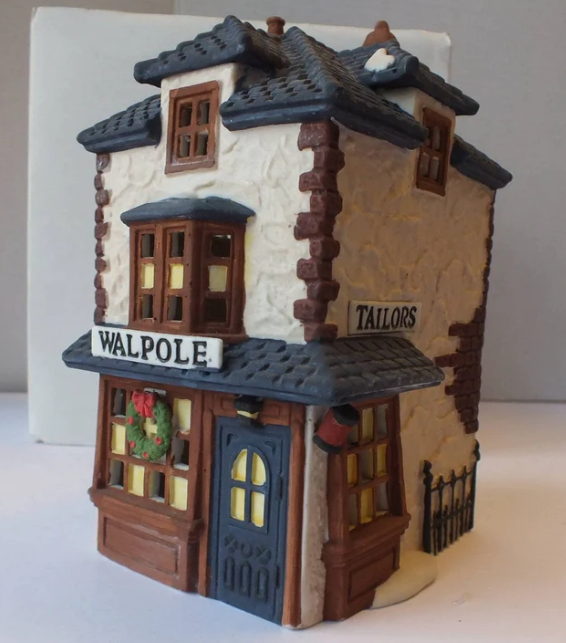
I drove my son to Trader Joe’s late this afternoon, through the windy northwestern suburbs of Philadelphia. We laboriously crossed the Schuylkill on the elegant but congested Green Lane Bridge, then wended through the glorious houses of the region that feeds into the elite Lower Merion School District. Many of them are mansions, estates even, and they all were tinged with delicate dabs of snow that immediately reminded me of Dickens Village houses. It occurred to me that I had almost never seen snow in such a remaindered state in real life, but I could place it immediately on ceramic depictions of Victorian London.
My father loved the Dickens Village houses. Made by Department 56 starting in the mid-80s, they captured both his narrative imagination and his love of architecture. We were not exactly flush for much of the late 80s and 1990s, but my father could justify an occasional extravagance if it promised the ultimate payoff of a collectible. Indeed, the closest he ever got to sufficiently explaining the holistic enigma of the Baby Boom generation to me was through this lens: how the same people could epitomize both Flower Power and the Reagan Revolution (not to mention Clinton, W, and Trump!). His answer was that they always wanted to be on trend, to follow what was cool, and that was as mercurial as the times themselves.
So every Christmas for much of my childhood, it became a tradition to select one and perhaps two new additions to the growing village that sat nestled on fluffy fake snow beside my mother’s childhood Lionel train and the neatly wrapped books and games we would exchange. Like everything in our house, these fragile painted porcelains were to be treated with the utmost care: poking the sensitive undersize bulbs into the rounded holes in back, hiding the cords amongst the felt tufts. Just thinking about it, the hirsute goosebumps alight on my arms as I remember the clanking of metal against the house edge, a chalkboard sensation that is slightly intriguing but more often overwhelmingly intense. As though my whole body were consumed in a jarring tingle. It is only in the reflection of my son that I have come to see how deeply my life has been governed by sensory sensitivities I’ve often presumed were universal, or at least widespread.
After we began collecting and the first furtive Christmases of acquisition repeated, I came to anticipate these pre-Christmas gifts almost more than those concealed under the tree. Perusing the glittering offerings neatly staged in the one or two local shops that carried them. Deliberating with my dad about the merits of a new release or an oldie we’d long considered. And after the final choice, the glorious feeling of sliding the thin monochrome cover (thinner than cardboard but thicker than paper) off the styrofoam box, then finding the little deliberate notch in the styrofoam to gently (so gently!) remove the cover and just admire. The handpainted craftsmanship. The little nooks and details. The dabs of snow here, and in the corner over here.
I never considered it too deeply at the time, but I suppose the quantity of snow was a compromise between the desire to show the full construction of a roof (thatch for the Cratchits’ House, slate for Scrooge and Marley, or even tile for Wong’s when my father finally gave into the temptation to anachronism and expand our village to more contemporary Department 56 offerings) and the compulsion to stay in the spirit of a white Christmas. Upon reflection, rooves as heavily laden with snow as the ground we laid around it would have looked bizarre, giving the whole village a whitewashed feel. And so the dabs, little references to snow a few days into decay, just as we have around Philadelphia now, our first snowy month after a record time without.
A few years into collecting, my dad became drawn to a particular Dickens Village shop. It was humbler than some (we had long coveted Victoria Station and its hefty three-digit pricetag), but classic, good contrasting colors, nice illumination. He lifted it once, twice, set it down, gave me a knowing look. “I think we should get this one,” he said with some finality.
There was only one problem. We already had it.
“Dad, we have that one.”
“No, this one!” He lifted again. “Walpole Tailor.”
“Yes, Walpole Tailors. We have it. It was one of the first ones we got.” I couldn’t believe it. I actually suspected that, after perhaps Scrooge and Marley, it was the very first village piece we acquired. I had them all memorized, still, a feat that was nothing for an avid baseball card collector and Geography Bee contender, but I could imagine forgetting one of the more recent purchases, blending it with the prior year’s runner-up. But c’mon.
He looked skeptically, but his eyes glinted with just a hint of amused self-doubt. “Are you sure?”
“Positive. I promise. If we get it and bring it home, we’ll have to bring it back tomorrow. Or we’ll have two.”
“It’s a really nice one, though. And look, they’re retiring it soon. This may be our last chance.”
“Let’s get a different one tonight. And if we don’t have it, we’ll come back and I’ll pay for it.”
“You don’t have to do that, Storey.” He looked genuinely concerned at that point, though perhaps equally worried that we really would be going home without Walpole Tailors as that I would forgo so much allowance, or gift-giving opportunity cost, to prove a point about my memory.
“I’m serious. Pick something else. What about the theater?”
We didn’t get Walpole Tailors that night. And sure enough, when we went home, I hauled out the tub of carefully packed styrofoam boxes. Triumphant, I held it aloft. “Walpole Tailors!”
Two years later, the scene repeated almost precisely. Except this time, his insistence was stronger. As was my incredulity. At one point, I even referenced the earlier incident. “That wasn’t this one!” He was sure. “This is Walpole Tailor!”
Again, we didn’t buy it and again I was vindicated. I was a teenager now and took my gloating to some sort of extreme (a habit I would keep long after my accumulated years hit 20). It served one purpose beyond fueling my ego: he remembered thereafter. And it quickly became an annual tradition that he would find the Walpole Tailors still on offer at any given store and present it to me as though he’d forgotten again and play at insisting we get it until it devolved into laughter.
Not long after, the Walpole Tailors (retired years earlier but still for sale) finally dried up. The joke persisted, my father taking great pains to settle his seriousness and timing to catch me off-guard. It even bled into other arenas where purchases were considered or memory was questioned. It became a meme. To the point where when I brought Alex home one year via Chicago Midway, an airport she twice insisted she’d never visited after we’d been there together, I didn’t even have to tell the story to catch him up.
“You’re getting a new airport on the way back, Alex!” I exclaimed.
“Oh really?”
“Yeah, Chicago Midway!”
She silently rolled her eyes. “Very funny.”
“What’s this?” my dad inquired. “Has she been or not?”
“It’s our Walpole Tailors,” I said.
Two Christmases ago, our last in Albuquerque, Graham showed an interest in the Christmas village. My parents had long foregone the practice of reboxing most of the now extensive collection, instead leaving out many pieces year-round to deepen the feel of the library or watch from a high ledge in the kitchen. And the timeline had become more eclectic, Gatsby and New England and even a few off-brand offerings finding their place among Christmas Carol England. My Dad was sure that Graham would know to treat the lower-standing pieces with the reverence and deference we’d found innate since we first brought one home. Forgetting, perhaps, that he was barely 2, or his own endless memories of being admonished with the dreaded “one finger, Donnie.” (Of course, it was probably just his willful resistance to his own upbringing, seven decades on, that fueled his desire to offer Graham the respectful presumption he wished for himself when he heard “one finger, Donnie.” We’re always fighting the last war.)
Graham was initially almost afraid of the village pieces. My father actually encouraged him to reach out and touch one. But after a couple days of getting acclimated, curiosity got the best of him and he gently knocked one over, cracking the Art Deco sign off its front wall. My mother was watching him at the time and was quite upset when it happened, my father slightly more so, and both were determined to not let me find out. I did not long thereafter, as emotional weights do not go unburdened in my family. I felt bad and my father felt shame and my mother felt it was all a little too much. I can picture the fault lines of the damaged sign, the exact curvature, joining the canon of guilty Christmas breakings that line the halls of my memory. The Christmas in the City nightclub had been unplugged, wrapped in its own cord, with the sign fragment set gently atop the roof for safekeeping.
It still sits there today, in the library, on the shelf just out of Graham’s two-year-old reach. And my father is gone.
What we love about things is that they persist. They promise to linger even after we ourselves are gone. To maintain their familiar shape, their comforting structure, their solidity. But of course, this too is their unforgivable curse.
We bought perishables today. Fruits and vegetables, flowers and bread, tofu and chips. Graham wanted a snack and delighted in a free sample of gnocchi alla Sorrentina, blowing on it melodramatically to cool it before consuming. We drove home in the failing light of a February evening, headlights illuminating the windswept drifts of snow adhering to the rooves and chimneys of Main Line mansions in the Pennsylvania dusk.
This is the 19th post in the One Thing series.
Last Five
#18: Concussion Protocol
#17: Sifting Rocks in the Hot Sun
#16: Fifteen Nails
#15: Old Friends
#14: Mailing it in
Introduction & First Four
#4: Forgive, Don’t Forget
#3: Call Your Mother
#2: In the Land of Make-Believe
#1: Wistful Wisteria
Introduction: Announcement and Rules



